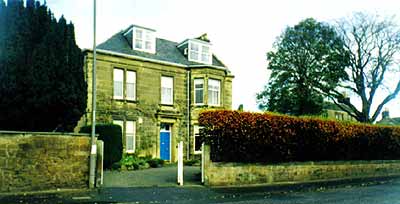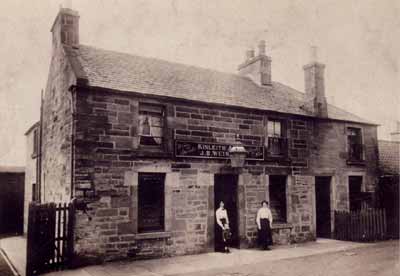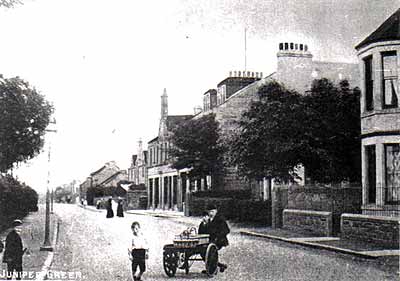Observations from the census returns from 1861 to 1901
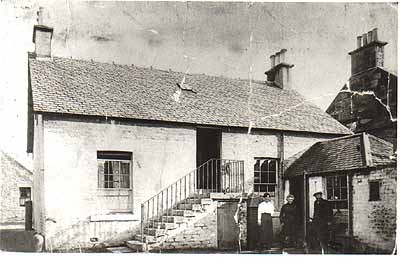
Cottages like Park End on Belmont Road housed two families, one upstairs and one downstairs
The latter half of the nineteenth century saw a massive increase in the population of Juniper Green and also some interesting changes in occupations as commerce progressed and the mills developed. Houses increased from 170 to 395 in 1901 and there were no less than an average 38 homes unoccupied during the 1881, 1891 & 1901 census' which suggests a far higher movement both in and out of the area. The population of the village increased accordingly from 698 to 1660.
FAMILIES
During this Victorian era the trend to larger families was very apparent in Juniper Green with no fewer than 35 (12%) families having 6 or more children by 1891. Looking at the upper ages suggests that some will have had more children who will have moved out of the family home. The larger families were as follows:
| 7 children: | ||
|---|---|---|
| Peter Malloch | School House | ages 8-20 |
| Alex & Margaret Walker | "Helen Bank" | ages 13-39 |
| John & Morag Frew | "Fern Cottage" | ages 1-13 |
| John & Isabella Alison | Belmont Avenue | ages 7-23 |
| William & Charlotte Dea | "The Cottage" | ages 1-14 |
| Bernard & Janet Gurney | "Woodhall Cottage" | ages 2-16 |
| 8 children: | ||
| James & Elizabeth Brown | "Hawthorn Cottage" | ages 5-20 |
| Adam & Marion Bryden | Kelvin Place | ages 2m-15 |
| William & Agnes Thomson | "Annfield" | ages 1-7 |
| Peter & Helen Anderson | Belmont Road | ages 4-18 |
| David & Helen Dickson | South Park | ages 9m-18 |
| Samuel & Agnes Brown | Tyne Place | ages 4-24 |
| Elizabeth Graham | "Post Office" | ages 11-26 |
| William & Anne Scott | "Grocer" | ages 10-25 |
| 9 children: | ||
| James & Morag Law | South Park | ages 1-18 |
| 10 children: | ||
| James & Marjory Turner | "Hillmount" | ages 1-19 |
| Andrew & Elizabeth Nisbet | "Midmar" | ages 1-17 |
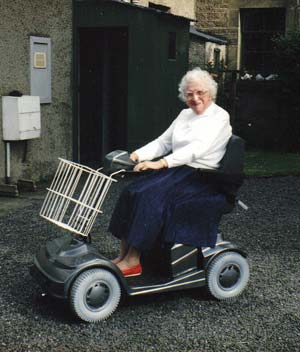
Frances Elizabeth Turner, born 11th April 1896 at 11.55am in Juniper Green lived on to be over 100 years old
By the end of the century 36 (10%) of the families had a head who was born in Ireland, although many of the children had been born in Scotland and looking at the ages suggests that many of them had come over either single or married at the time of the potato famine. However, few Irish families moved this far out compared to some other areas of Edinburgh where there was a vast increase in some parts of town (up to 28% of the population. This had meant the urgent building of more Roman Catholic Churches in some parts of the city.
HOUSING
Another interesting observation from these earlier census returns is the number of rooms in a house with 1 or more windows! Although the majority of homes had two or more rooms most of Baberton Avenue & Belmont Road had only 1 room with a window. The largest family living in these cramped conditions was that of Adam & Marion Brydon of Kelvin Place who had 8 children, 10 of a family in a house with 1 room with a window!
At the other end of the scale there were 53 (14%) with 7 or more rooms, the largest non estate houses being:
- MUIRHOUSE at Curriemuirend with 14 rooms
- GLEN ELVIN in Foulis Crescent with 13rooms
- MONTPELIER with 10 rooms
- GOWANLEA on Lanark Road with 10 rooms
- THE BIELD on Lanark Road with 10 rooms
- THE RAILWAY INN with 10 rooms
- THE KINLEITH ARMS with 9 rooms
The house named Enterkin (next to Veitch's old shop) was named after Enterkin's Yett which was the north entrance to Woodhall. Enterkin in Ayrshire being where the first family (The Cunninghams) to own the charter to Woodhall originated.
OCCUPATIONS
This latter half of the nineteenth century saw some major changes in occupations where you can clearly see that fewer people were employed on the land (46 reduced to 23), whereas the industrial age was clearly growing through the expanding Mills along the Water of Leith (103 increasing to 228). The last ten years saw a huge increase in local residents employed in what we would now call "the retail trade" (9 up to 50). On looking through the occupations it is fascinating to see the huge diversity of jobs in the mills where there were no fewer than 20 different ones listed such as Dusterman, Beaterman, Finisher, Overhauler, Cutterman to name but a few.

Juniper Green says farewell to Boer War volunteers marching down Baberton Avenue from the drill hall established in 1900.
It is in the area referred to as the "Retail Trade" that seems of most interest with changes, as in the 1901 census you can clearly see a shift to people employed in shops. In fact, for a small place like Juniper Green these records appear quite astounding. Living in Juniper Green there were:
- Butchers 10
- Bakers 6
- Drapers 6
- Bootmakers 3
- Grocers 9
- Dressmakers 8
- Fruiterer 2
- Watchmaker 2
- Wholesale Drapery Traveller
- Commercial Hardware Traveller
- Brewer's Traveller
- Clothier Traveller
The identifiable shops in the village in 1901 were George McDonald the butcher at Middleton Cottage, William Scott the Grocer at Rosemary Cottage, James Fisher the Baker at Sunnyhall and Elizabeth Graham and family who were the entire Post Office staff at Mavis Cottage. She was the Postmistress while her son William was the Postman, Lillian & Jessie were Post Office Assistants and Jane was the Telegraphist. Juniper Green had its own village "bobbie" William Nichol at Murrays Buildings and believe it or not a Railway Police Supervisor James Allan who lived at Juniper Cottage.
The Inn at Curriemuirend was owned by a German family Francis & Catherine Greiner for many years. They had moved from Galashiels, although by 1901 they had moved on and William Bruce had become "mine host".
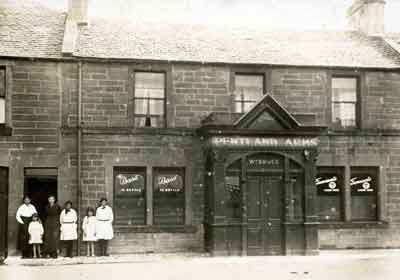
The Bruce family preparing to open on a Winter's day. Now known as Tanners this public house has had the previous names the Ship Inn, Curriemuirend Inn and the Pentland Arms.

